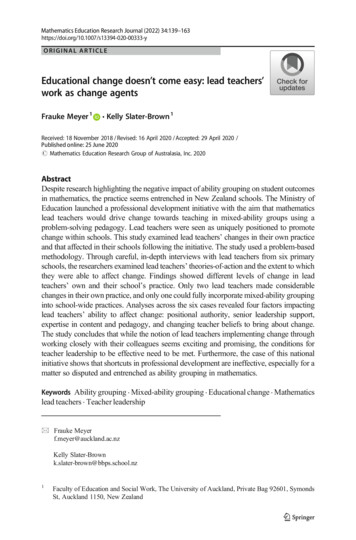
Transcription
Mathematics Education Research Journal (2022) 33-yORIGINAL ARTICLEEducational change doesn’t come easy: lead teachers’work as change agentsFrauke Meyer 1& KellySlater-Brown 1Received: 18 November 2018 / Revised: 16 April 2020 / Accepted: 29 April 2020 /Published online: 25 June 2020# Mathematics Education Research Group of Australasia, Inc. 2020AbstractDespite research highlighting the negative impact of ability grouping on student outcomesin mathematics, the practice seems entrenched in New Zealand schools. The Ministry ofEducation launched a professional development initiative with the aim that mathematicslead teachers would drive change towards teaching in mixed-ability groups using aproblem-solving pedagogy. Lead teachers were seen as uniquely positioned to promotechange within schools. This study examined lead teachers’ changes in their own practiceand that affected in their schools following the initiative. The study used a problem-basedmethodology. Through careful, in-depth interviews with lead teachers from six primaryschools, the researchers examined lead teachers’ theories-of-action and the extent to whichthey were able to affect change. Findings showed different levels of change in leadteachers’ own and their school’s practice. Only two lead teachers made considerablechanges in their own practice, and only one could fully incorporate mixed-ability groupinginto school-wide practices. Analyses across the six cases revealed four factors impactinglead teachers’ ability to affect change: positional authority, senior leadership support,expertise in content and pedagogy, and changing teacher beliefs to bring about change.The study concludes that while the notion of lead teachers implementing change throughworking closely with their colleagues seems exciting and promising, the conditions forteacher leadership to be effective need to be met. Furthermore, the case of this nationalinitiative shows that shortcuts in professional development are ineffective, especially for amatter so disputed and entrenched as ability grouping in mathematics.Keywords Ability grouping . Mixed-ability grouping . Educational change . Mathematicslead teachers . Teacher leadership* Frauke Meyerf.meyer@auckland.ac.nzKelly Slater-Brownk.slater-brown@bbps.school.nz1Faculty of Education and Social Work, The University of Auckland, Private Bag 92601, SymondsSt, Auckland 1150, New Zealand
140F. Meyer, K. Slater-BrownIntroductionThe purpose of this research was to examine the work of mathematics lead teachersin a national change initiative. The aim of the professional development initiativewas to enable lead teachers to drive change in their schools towards teachingstudents in mixed-ability groups. The well-established, and in some jurisdictionsincreasing (Hallam and Parsons 2013; Loveless 2013), practice of grouping students according to ability had come under scrutiny. International studies highlightits negative impacts on student self-efficacy, motivation, and outcomes (e.g., Iresonet al. 2001; Hallam and Parsons 2013; Lleras and Rangel 2008; Saleh et al. 2005).Ability grouping is seen as a major factor in the persistent inequity in mathematicsachievement in New Zealand and elsewhere (Schmidt et al. 2015). Research hasshown that students who are routinely channeled into lower ability groups get feweropportunities to learn higher order skills, internalize the low expectations teachershold for them, and as a result show lower self-efficacy compared with their peers inhigh ability groups (Boaler 2009; Chmielewski 2014).Lead teachers are seen as uniquely positioned to promote educational change. Theyunderstand the complexities of teaching and possess the necessary knowledge andskills to support teachers with content specific issues. Furthermore, their collegialstanding enables them to foster teacher collaboration (Curtis 2013; Mangin andStoelinga 2008; Muijs and Harris 2006). Lead teachers are often seen as teachersworking towards improvement and change for the whole school (Carpenter andSherretz 2012; Gaffney and Faragher 2010). However, only a few studies haveexamined the work of lead teachers as change agents in the context of school-widechange (Wenner and Campbell 2017).The study employed a problem-based methodology using semi-structured interviewswith lead teachers from six primary schools. Interviews were used to elicit leadteachers’ theories-of-action about their own practice and that in their school. Thesewere then used to describe and explain the extent to which lead teachers were able toaffect change in their schools. The research questions guiding this study were:&&&To what extent have lead teachers changed their own teaching practice?To what extent have lead teachers affected change in school-wide mathematicspractices?What factors might explain the degree of change achieved by lead teachers?Lead teachers as change agentsOver the past two decades, lead teachers have been recognized as important agents foreducational change and school improvement (Mangin and Stoelinga 2008; Muijs andHarris 2006; Harris and Townsend 2007). They are seen as having the capacity toencourage teacher collaboration and professional learning, model and proliferate bestpractices, and offer support with classroom or content-specific issues (Curtis 2013;Muijs and Harris 2003, 2006). As a result of lead teachers’ potential role in schoolimprovement and educational change, schools have increasingly created leadershiproles for teachers to use this “untapped” potential.
Educational change doesn’t come easy: lead teachers’ work as change.141However, there seems not one clear definition of lead teachers or a realization of theinherent complexities and factors that impact their change efforts (Knapp 2017; Manginand Stoelinga 2011). The term teacher leadership seems to encompass an expansivefield, multiple roles—formal and informal—, and differing expectations in regard toresponsibilities and expectations (Neumerski 2012; York-Barr and Duke 2004; Wennerand Campbell 2017). To guide the current study, we refer to the general notion thatteacher leaders influence others to contribute to school improvement and educationalchange (Katzenmeyer and Moller 2009; York-Barr and Duke 2004).In New Zealand primary schools, lead teachers are formally appointed in a specificcurriculum area, often based on their classroom teaching expertise. They are taskedwith procuring and sharing resources, organizing learning opportunities, and providingsupport to teachers. Their role does not hold any managerial responsibility or authorityover staff in their subject area, and they also tend to not be assigned any classroomrelease time for the role. The lead teacher role thus differs from Head of Departmentroles in secondary schools, which in a New Zealand primary school would be moreequivalent to a syndicate leader. Syndicate leaders are responsible for a team of teachersteaching multiple year groups, for example the junior or senior primary school years.Factors impacting the change efforts of lead teachersThe research literature identifies three main factors that may either enable or inhibitlead teachers’ change efforts, namely principal or school leadership support, access totraining and professional development, and lead teachers’ own positioning in the role.First, support from school leadership seems to be paramount for lead teachers tobe successful in their role (Camburn et al. 2003; Leithwood et al. 2004; Mangin2005, 2007). Such support involves fully understanding the responsibilities of thelead teacher’s role and being involved in and acknowledging their work. Forexample, Mangin (2007) noted that primary math lead teachers were more successful in their roles if they had school leaders who were knowledgeable about thecontent of lead teachers’ work, clearly defined their role and responsibilities, andwere involved in their work.Burch and Spillane (2003) found that principals who were engaged in the school’smath reform tended to show stronger support for their lead teachers’ efforts than thosewho left the reform efforts up to lead teachers alone. Teacher resistance to change canmake lead teachers’ work difficult and a perceived lack of support from the principalcan fuel such resistance (Margolis and Doring 2012). School leaders can further showacknowledgment and recognition of lead teachers’ work by providing them withclassroom release time for working with teachers, remuneration for the role, or otherorganizational support such as timetabling in a way to enable them to observe andsupport their colleagues (Chew and Andrews 2010; Gaffney and Faragher 2010;Gigante and Firestone 2008).A lack of time or structural resourcing was noted as a major barrier to lead teachers’work, as it would come on top of their already busy teaching workloads (Durias 2010;Margolis and Huggins 2012). Additionally, a shared vision for change can help leadteachers’ positioning in the eyes of staff members (Chamberland 2009; Margolis andDoring 2012; Muijs and Harris 2006). Researchers, however, seem divided on thequestion of how much authority and autonomy principals need to afford lead teachers.
142F. Meyer, K. Slater-BrownChamberland (2009) notes the importance of lead teachers being given autonomy andpositional authority to make decisions. Robinson (2011), however, asserts that it is roleauthority that is needed to impact change, which can only be bestowed on lead teachersby teachers’ judgment of their capability, not formal positioning (Katzenmeyer andMoller 2009).Second, there seems little preparation and training afforded to lead teachers. Programs vary widely from conferences, centralized professional development, localtraining programs to university master courses (Wenner and Campbell 2017). Mostprograms focus on content and pedagogical content knowledge, as it is this knowledgethat lead teachers are supposed to take and spread in their schools. Hofstein et al. (2004)note that while the development of leadership skills seemed to be neglected in the past,they have now become part of lead teachers’ preparation and training programs in theUSA. The scant research on preparation, training, and professional development forlead teachers ascertains that the programs under study had been valuable for leadteachers’ work directly and for forming partnerships and support networks (Durias2010; Hanuscin et al. 2012; Hofstein et al. 2004; Vernon-Dotson 2008).Third, lead teachers’ own perceptions of their role can either support or hinder themin fulfilling it. The lead teacher role is often perceived as blurring the line betweenteachers and leaders in schools and lead teachers can struggle to define and identifywith their own role (Struyve et al. 2014). Chamberland (2009) and Brosky (2011)highlight that those lead teachers who were adamant or hesitant to act and positionthemselves as leaders have difficulties working effectively. Similarly, those with littleconfidence in their own knowledge and practice or those who were novices in their roleoften struggle to lead (Durias 2010; Muijs and Harris 2006).Leading change for equity—the case of ability groupingin mathematicsWenner and Campbell (2017), in their review of research on lead teachers, highlightedthat there is a dearth of research exploring lead teachers’ experiences in specific subjectcontexts and their role in equity and social justice issues. This research into leadteachers’ change efforts in regard to ability grouping in mathematics addresses bothof these gaps. Ability grouping is an entrenched practice in most countries, includingNew Zealand (Anthony and Hunter 2017; McGillicuddy and Devine 2018; EducationReview Office 2013).Ability grouping in primary schools can occur both within and between classes. Themost prevalent forms are within-class ability grouping, where children are grouped byability within the classroom, and between-class ability grouping, where children areplaced into ability groups across a grade. Grouping practices are often perceived, byboth policymakers and teachers, as effective in meeting the needs of children in termsof curriculum level and efficient in terms of planning (Hanushek and Woßmann 2006;Hornby et al. 2011). However, research evidence highlights that ability grouping is amajor contributing factor to the persistent inequity in current mathematical results.Students from low socio-economic backgrounds and those from minority groupspresent the “low tail of achievement” (Boaler 2009; Causa and Chapuis 2009;Chmielewski 2014; Schmidt et al. 2015). It is these students who are routinely routed,
Educational change doesn’t come easy: lead teachers’ work as change.143explicitly or implicitly, into lower ability groups and as a result miss out on higherquality instruction, more teaching time, and more content-laden and challengingcurriculum (Hallam and Ireson 2005; Mayer et al. 2018; Schmidt et al. 2015; Taylor1993; Youdell 2000). This has been noted as a concern especially in the New Zealandcontext (Ell 2013; Schmidt et al. 2015). Students in lower ability groups oftenexperience negative teacher and peer interaction and lower expectations leading tonegative self-efficacy beliefs and disengagement from the subject and school (Iresonet al. 2001; Marks 2012; Rubie-Davies 2014).Given that those students who arrive at primary school with lower achievementlevels are typically from minority ethnic groups or low-income families, ability grouping seems to exasperate their challenge to catch up. Schmidt et al. (2015), in an analysisof the Pisa 2012 data, highlighted how grouping practices are perpetuating educationalinequity. In some countries, the achievement gap seemed mostly due to between-schoolinequalities in learning opportunities. However, in other countries, for example in theUSA and New Zealand, there was a pattern of within-school inequity in learningopportunities that is strongly linked to the achievement gap (Schmidt et al. 2015). Thissuggests that the persistent and growing achievement gap might be an “opportunitygap” as grouping students by ability results in differential exposure to mathematicalcontent and opportunities to learn.The New Zealand contextFollowing a report in 2015 (Education Review Office 2013) that documented thewidespread use of ability grouping, the Ministry aimed to provide a renewed pushfor mathematics instruction in mixed-ability grouping paired with a problem-solvingpedagogy. A problem-solving pedagogy was already one of the five componentsmaking up the process strand for the 1993 New Zealand Mathematics Curriculum,but it seemed not to have been widely adopted. A problem-solving pedagogy movesaway from the traditional way of teaching mathematics, involving memorization andapplication of memorized procedures to solve routine problems (Cai 2003; Schoenfeld2016; Stein et al. 2009). It rather encourages learning through problem-solving, wherechallenging mathematical problems are presented. Such problems allow for varioussolution strategies to be applied, have multiple solutions, and are cognitively demanding—so-called non-routine problems (Chapman 2015; Romberg 2016). Students learnmathematics through finding solutions, presenting reasoning, negotiating differentsolutions, and creating a shared understanding. Problems should resemble real situations in their richness and complexity to enable students to gain transferable skills(Schoenfeld 2016). The teacher’s role is to pose open-ended problems and create anenvironment in which students can develop their problem-solving skills in collaboration with others. As Chapman (2015) notes, teachers need to be proficient in problemsolving, able to pose challenging problems, model problem-solving, and understandhow to help students to become better problem-solvers to be effective in teachingmathematics through problem-solving.The Ministry set out a multi-pronged approach with the main focus on leadmathematic teachers, recognizing their potential to drive change. One of the Ministry’sinitiatives was a national rollout of professional development for lead teachers in their
144F. Meyer, K. Slater-Brownregional cluster meetings. Regional clusters include lead teachers from about ten totwenty schools. Cluster meetings are scheduled each term and last a half day. Theprofessional development provided an overview of the latest research and new practices. However, attendance at cluster meetings is voluntary and no follow-ups to theprofessional development were offered where practices could be modeled or teacherssupported in implementing new practices in their classrooms. However, schools couldpay for extra support from external consultants to work with staff and teachers couldfind further resources and teaching materials on a resource website (nzmaths.co.nz).The website is frequently used by mathematics teachers, and over the last few years,more resources for problem-solving activities have been added.Besides the fully funded professional development at cluster meetings, lead teacherscould opt for partially funded training opportunities. First, the Mathematics SupportTraining (MST) that included two postgraduate papers, mentoring, and classroomrelease time to apply learning in one’s own context. Second, the Accelerated Learningin Mathematics (ALIM) program, which provided funding for classroom release timeto engage in inquiry cycles supported by a mentor. Inquiry cycles (see Timperley et al.2014) are a tool promoted for teachers and leaders in schools to examine their ownpractice and its impact on student outcomes.All three initiatives delivered the same research-informed message that a change tomixed-ability grouping is needed; however, there were no accountability measures inplace for lead teachers or schools to put the recommended changes into action. Thispaper examines the work of lead teachers, who have attended the cluster meetings, aschange agents in their schools. It aims to investigate the changes lead teachers havemade in their own practice, the change they were able to affect in school-wide practices,and the factors impacting them in their work. The paper thus addresses the call for moreresearch into lead teachers’ work, especially in specific subject contexts.MethodologyIn the following, we outline the methodological framework and research approach usedin this study. We further provide details on the sampling strategy and the participants.Finally, we describe and justify our methodological decisions and procedures in regardto the data collection and analysis.Methodological frameworkA problem-based methodology (Robinson 1993) was used to understand the theoriesof-action of mathematics lead teachers who were charged with leading change in theirschools. A problem-based methodology seeks to uncover the problem-solving processes that lead to the adoption of a specific solution to a practical problem. In this research,the practical problem under examination was how students were grouped in mathematics classrooms. The focus is on the work of the lead teacher in solving this problemin their own practice and with staff in their school. To uncover the underlying processesor drivers of the problem-solver’s actions, the analysis focuses on lead teachers’theories-of-action.
Educational change doesn’t come easy: lead teachers’ work as change.145Theories-of-action were first described by Argyris and Schön (1974). They can beseen as maps to people’s beliefs and actions when solving practical problems, and theconsequences of their actions. Theories-of-action can describe these relationships on anindividual, organizational, or societal level. In this research, the focus is on leadteachers’ theories-of-action and the perceived theories-of-action of staff in theirschools. There are two types of theories-of-action, espoused theories and theories-inuse. Espoused theories-of-action are those “that people claim, believe, or report to bethe basis of their action” while theories-in-use are those describing “how peopleactually behave, as directly observed or recorded” (Robinson 2014, p. 808). Throughour interviews and in-depth analysis of lead teachers’ accounts, we aimed to capturesome insight into lead teachers’ theories-in-use; however, we acknowledge that nodirect observations or triangulation of data has taken place through interviews withother school staff. We thus stay with the overarching term of theories-of-action in ouranalysis and reporting, as described in Robinson and Donald’s (2014) outline of theapplication of the problem-based methodology and exemplified in a case of curriculumadaption and implementation of an integrative curriculum.Theories-of-action describe the links between people’s values and beliefs, theiractions, and the resulting consequences. People’s actions include actions and nonactions. What kind of actions people take depends on a set of constraints. These includetheir values and beliefs about the task, themselves, and contextual factors (Argyris andSchön 1974, 1978; Robinson 1993, 2014). In the case of a teacher changing his or herown practice, constraints might include perceptions about their own ability, the perceived effectiveness of the new approach, the amount of work it entails, and theperceived suitability of the new approach in the given context. The process of solvinga problem, for example, changing one’s practice, involves finding a solution which bestintegrates the different constraints. The consequences of people’s actions can beintended or unintended. Examining theories-of-action means to examine beliefs, actions, consequences, and their relationships. It means to examine more in-depth thedrivers of people’s actions and to “go beyond seeing what they do to understandingwhy they did it” (Robinson and Lai 2006, p. 19).The in-depth focus of the problem-based methodology on the drivers of people’sactions links back to its’ purpose “to explain, evaluate, and improve teaching practicesin ways that are rigorous as well as relevant to the particular context in which a teacheris working” (p. 15). To improve practice and change teacher behavior, one needs tounderstand what drives the behavior as without changing the underlying drivers,practice will resort to old routines (Timperley et al. 2007).Research approachA qualitative approach was chosen to enable the in-depth examination of lead teachers’theories-of-action (Basit 2010). Qualitative semi-structured interviews ensured thatparticipants’ voices were heard and for the researchers to probe participants’ perceptions and beliefs about the problem of changing grouping and teaching practices inmathematics classrooms. The ideals of qualitative research, as valued by the researchers, are best captured by Watling’s (2002) description: “the qualitative researcheris likely to be searching for understanding rather than knowledge, for interpretationsrather than measurements, for values rather than facts” (p. 267).
146F. Meyer, K. Slater-BrownThis study is grounded in the interpretive paradigm (Basit 2010) as it seeksto discover, explain, and interpret social phenomena and is responsive to arange of contexts (Neuman 2003). The interpretation of reality is viewed associally constructed; therefore, the interpretation of reality needs to be understood from the people being studied (Merriam 1998), in this case, mathematicslead teachers. A qualitative interpretive approach provides an in-depth understanding, including participants’ circumstances, experiences, and histories(Ritchie and Lewis 2003).ParticipantsThe sampling for participants was restricted to compare cases that had similaraccess to professional development opportunities and were accessible to theresearcher. Hence, this research utilized a purposeful, convenience samplingprocedure (Creswell and Poth 2016). Three criteria were used to sampleparticipants: (1) lead teachers had to be in the role for at least six months,(2) their schools had to be in one specific cluster of eleven schools that wasprovided with professional development at cluster meetings, and (3) leadteachers needed to have attended the cluster meetings in the last six months.It has to be acknowledged that the cluster of schools approached for the studyincluded only high-income schools, which limits the interpretation of results inregard to schools with greater diversity in their student population and potentially greater achievement challenges. Six lead teachers from different schoolswithin the cluster were interviewed (see Table 1).They were from mid-size, high-income schools. Two lead teachers were also deputyprincipals. While four lead teachers had been in the role for more than five years, onehad only two years’ experience and one had just passed the six months mark in the role.All of the lead teachers had attended the professional development at the clustermeetings, two also had external consultants working with them, and two had eitherenrolled in the ALIM or MST program. Neither of the authors had any connection to orroles in these programs.Table 1 Participant characteristicsTeacher*Other positionExperience in rolePD programSchool rollMoiraClassroom teacherMore than 5 yearsCluster meetings511PoppyDeputy principal6 monthsCluster meetingsALIM445SueClassroom teacherMore than 5 yearsCluster meetingsExternal consultant550JoClassroom teacher2 yearsCluster meetings307RuthDeputy principalMore than 5 yearsCluster meetingsExternal consultant416LynDeputy principalMore than 5 yearsCluster meetingsMST196*Pseudonyms are used to ensure confidentiality
Educational change doesn’t come easy: lead teachers’ work as change.147Data collectionSemi-structured interviews were used which allowed for the collection of rich anddetailed descriptions in regard to lead teachers’ theories-of-action in regard to change intheir own beliefs and practice, and their impact on change in school-wide practices. Thesemi-structured nature of the interviews allowed for a systematic comparison acrosscases and the potential factors impacting on their work (Merriam 1998).In the interviews, one of the researchers probed lead teachers’ perceptions of theirown personal practice, their understanding of recent professional development, andtheir beliefs about teaching mathematics, and changes in their practice following theprofessional development. Interviews further explored whether lead teachers perceivedto have affected change in school-wide practices, their views of colleagues’ reactions,and what support and barriers they experienced. While interviews often focus onparticipants’ actions and perceptions, the researchers set out to probe deeply into thebeliefs, reasoning, and other constraints that might have driven lead teachers’ actions.The interview guide (see Appendix) was piloted with a mathematics teacher notinvolved or participating in the research. Minor adjustments to the interview guide weremade where questions were unclear or did not elicit the information sought. Interviewslasted approximately forty minutes and were conducted at a place convenient to thelead teacher. The interviews were audio-recorded and transcribed for analysis purposes.Data analysisFirst, an analysis of interview transcripts focused on completing detailed accounts oflead teachers’ theories-of-action uncovering their constraint structure. The analysisfollowed a deductive approach identifying instances in the interview transcript in regardto lead teachers’ actions, constraints (beliefs, reasons, conditional factors), and consequences (Boyatzis 1998; Braun and Clarke 2006). The second author identified andsummarized the specific actions, constraints, and consequences to draw up a theory-ofaction table for each lead teacher.Second, the same analysis procedure was employed to examine lead teachers’perspectives on school-wide practices and complete theories-of-action for the staff theyworked with. While these theories-of-action were completed from the perspective ofthe lead teacher, and staff were not interviewed for their own views, they do give us anindication of the challenges and support mechanism encountered by lead teachers.Third, theories-of action were compared across these six lead teachers and schools.Different levels of change in lead teachers’ own practices and school-wide practiceswere identified: limited, some or substantial change. Where lead teachers were unableto implement any or only little change in their own practice, we noted a “limited”change in practice, while lead teachers that partly implemented mixed-ability groups oremployed a problem-solving pedagogy were seen as having implemented “some”change. Only lead teachers who ceased to use ability grouping and used a problemsolving pedagogy were categorized as having made “substantial” change. The samecategories were applied for change in school-wide practices.Finally, an inductive approach was taken in looking across the theories-of-action andthe coded data to identify common patterns in the factors that might have enabled orhindered the work of the lead teachers (Boyatzis 1998; Braun and Clarke 2006). Four
148F. Meyer, K. Slater-Brownmain factors were identified: the positional authority of lead teachers in their schools,the support of senior leadership, the expertise of lead teachers, and the persistence ofbeliefs about ability grouping.At each step of the analysis, theories-of-action were carefully cross-checked by thefirst author against the coded data, actively seeking clarification and disconfirmation.Furthermore, both authors checked the linkages between constraints, actions, andconsequences to check for missing constraints or links. For example, most often thereis not a single constraint that determines an action, but a set of related constraints. Anaction that could not be set in relation to a set of constraints, or vice versa, indicated thatthe analysis failed to identify a constraint. The inductive coding, co
curriculum (Hallam and Ireson 2005; Mayer et al. 2018; Schmidt et al. 2015; Taylor 1993;Youdell2000). This has been noted as a concern especially in the New Zealand context (Ell 2013; Schmidt et al. 2015). Students in lower ability groups often experience negative teacher and peer interaction and lower expectations leading to



![Change Management Process For [Project Name] - West Virginia](/img/32/change-20management-20process-2003-2022-202012.jpg)






